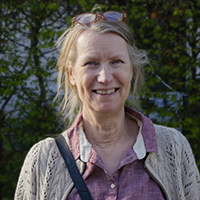Urban trees are more than just aesthetic features, they can play a major role in cooling our cities and making them more livable. An article from KTH highlights research on how strategic planting can reduce temperatures and improve comfort for residents.
Surface temperatures in a city are affected by trees. This is shown by measurements that researchers Ulla Mörtberg, professor of energy systems analysis and environmental assessment, and Elina Merdymshaeva, doctoral student and geographic analyst, carried out over three months in the summers of 2022 and 2024 in different parts of Stockholm.

Ulla Mörtberg, Professor of Energy Systems Analysis and Environmental Assessment. Credit: KTH.
Measuring surface temperatures in a city is nothing new, and usually satellites or drones are used to take the measurements. To get a more accurate picture of surface temperatures in Stockholm, the researchers used garbage trucks, three-wheeled electric mopeds and electric bicycles, among other things, on which they mounted scanners with IR cameras. With the help of these, they were able to measure the outside temperature on facades, in the street space and around existing greenery. The measurements were taken in Hammarby sjöstad, Södermalm and around Norr Mälarstrand in Stockholm.
– We were able to localise which facades are warmer and which parts of a street are more exposed to heat, says Elina Merdymshaeva, PhD student and geographical analyst.
Trees play a role in shading and cooling
In their measurements, the researchers looked at observation areas that are stable over time and looked at the volume and surface of buildings. In their measurements, they used machine learning to identify relationships and combinations of variables, and they also made extensive use of the City of Stockholm’s tree data. The researchers examined landscapes, neighbourhoods and a micro-scale, where they were able to get more detail than before.
– The new thing we saw is that you can link surface temperatures to how the sun lies on building facades and how the trees interact with it, on a micro-scale, but across the entire urban landscape. That there is a relationship between these two things. Trees are important for shading and cooling, says Ulla Mörtberg.
The measurements are intended to support the planning of new residential areas and to plan for greenery.
– We may not be able to continue planning as if we were in an Arctic climate, as this has been done because it costs energy to heat the houses. Now it costs energy to cool the houses instead. Alternatively, you get health problems, and we have seen that this has increased. It is better to have an outdoor environment that is more cooling, says Ulla Mörtberg.
Could lead to greener cities with more cooling spaces
The measurements also show the impact of urbanisation. Heat islands occur where there are many large buildings over large areas.
– You can think about how to build to create a pleasant microclimate for the people living in an area. Greenery is something you can compensate for, and this research can lead to greener cities with more cooling spaces.
The researchers will now continue to look more closely at which tree species are best to plant for cooling, which is why they are also conducting a survey on heat for Stockholmers to answer during the summer of 2025.
– When it comes to microclimates, it’s important to think about which directions you build in. As for trees, they should be an important part of the construction process, both planting new trees and taking into account existing trees in the construction process, says Ulla Mörtberg.
Survey on perceived heat
Participate in the survey on perceived heat: https://app.maptionnaire.com/q/9b26m426v3h4
The original article written by Emelie Smedslund was published at KTH Royal Institute of Technology (June 26, 2025): https://www.kth.se/en/om/nyheter/centrala-nyheter/trad-viktiga-for-att-sanka-yttertemperaturen-i-stader-1.1409927
Did you know you can visit Hammarby Sjöstad? Read more about it here.